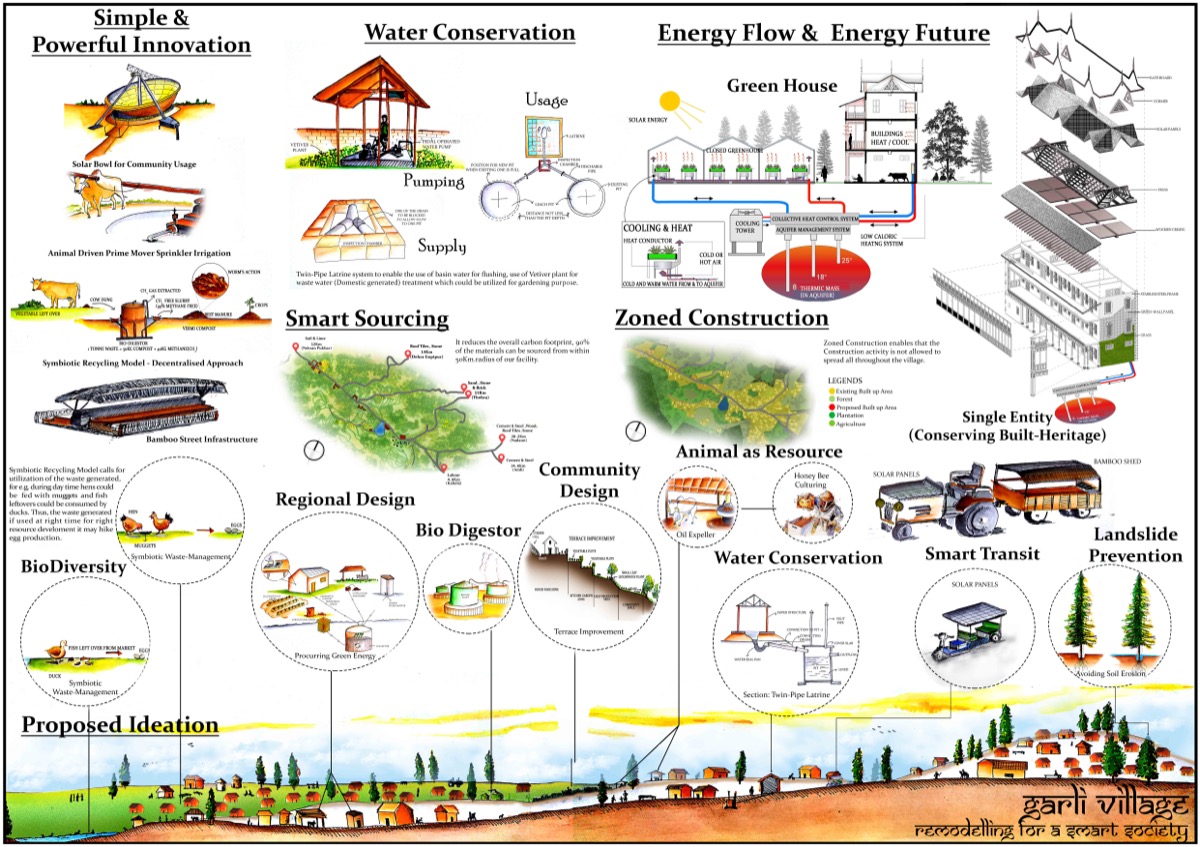The Garli village, Kangra district is one of the first villages of India to have ‘heritage zone’ status. The village is the original homeland of Sood community. They showcased their opulence for by building monuments, villa & bungalows in their local village Garli. The structures in this village have a blend of many architectural styles with Indo-Saracenic as a predominate one. Most of the building in this village represents power & influence of Britishers who chose Shimla as their summer capital.
Most problems in rural India are universal and can be addressed where ever one is with simple and innovative Architectural Interventions, on the contrary, Re-modelling of the village on a hill for a smart society calls for several additive contextual factors like Landslide Prevention, Smart Sourcing, Use of Animal as a Resource, Zoned Construction etc. Thus, the basic concept for SMART Society undertaken is this development is Transforming settlements from within by focussing on Regional & Community Design, Water Conservation, Energy Flow & Energy Future, Judicious Land use & Site Ecology, Bio-Diversity with ‘Highest Sustainability’ as a Concept at stake in an Architect’s Hand. ‘
The predominant simple and powerful innovations undertaken in this proposal include Solar Community Kitchen, Twin-Pipe Latrine system to enable the use of basin water for flushing, use of Vetiver plant for waste water (Domestic generated) treatment which could be utilized for gardening purpose and Stormwater could be treated for drinking purpose or recharging of the water table. Further, one of the 5 HP submersible pumps could be replaced by Bull driven borehole lineshaft pump. This pump is a positive displacement screw pump that is driven by two bulls connected to the pump rotor through a gear and chain and pulley arrangement. Furthermore, Bull driven oil expeller and flour mill demonstrate the utility of bulls and this helps to make oil and flour in an eco-friendly fashion. Also, use of bio-digestors enables the use of Biomass as a renewable energy resource derived from the carbonaceous waste of various human and natural activities. Biomass does not add carbon- dioxide to the atmosphere. Moreover, Symbiotic Recycling Model calls for utilization of the waste generated within a stipulated time frame, for instance during day time hens could be fed with muggets and the left out of the same could be eaten by frogs during night and fish leftovers could be consumed by ducks. Ultimately the waste generated if used at right time for right resource development we may end up with the production of eggs in the morning. On Similar vision, we may sanitize dumping ground waste with Natural & Herbal enzymes, with this the natural waste shall be decomposed with flies’ action and the scrap & plastic shall get segregated on its own to be sent at the recycling yard.
Besides these, the evolution criteria’s include smart sourcing that is to reduce the overall carbon footprint, 90% of the materials can be sourced from within 50 Km. radius of our facility. Then, Zoned Construction enables that the Construction activity is not allowed to spread all throughout the village. It should be restricted to only some areas with all the sun-dried brick production units strategically placed near those areas to minimize transportation activity. Further, Garli Village shall focus on the behaviour and impact of the occupants, with less reliance on technology for generating energy. Everything from choices made during construction to the way occupants eat and sources of food is governed by local resources.
On a Concluding note, the need of the hour states that wastewater management system and Symbiotic-Recycling model, linked with biogas generation on site, Water Conservation, and Organic Farming etc. should be basic parameters for design consideration of Rural India.
Alternative Energy Bio Gas
Cost saved = Money earned. We would like to give a brief idea as to how shifting to bio gas generation may help us cut down costs. Below data is as of Dec 2016 for Garli Village.
| 1. |
Number of LPG cylinders saved per month |
06 |
| 2. |
Amount saved per month on LPG cylinders |
Rs. 78,000.00 |
| 3. | Savings from Slurry per Month (Market value of raw Materials, saved) |
Rs. 11,000.00 |
| 4. |
LPG procurement costs (For shuttling between Town and Village) |
Rs. 4,000.00 |
| 5. |
Amount saved on Fuel per month |
Rs. 2,000.00 |
| 6. |
Total savings and revenue |
Rs. 95,000.00 |
|
MONTHLY COSTS INCURRED |
||
| 1. |
Salary for One person |
Rs. 5,000.00 |
| 2. |
Maintenance cost |
Rs. 3,000.00 |
| 3. |
Fuel Cost per month |
Rs. 6,000.00 |
| 4. |
Diesel cost per month for running the pulveriser and blower |
Rs. 4,000.00 |
| 5. |
Total Cost incurred |
Rs. 18,000.00 |
| NET SAVINGS | ||
| 1. |
Net Savings per month |
Rs. 78,000.0 |
PAPPAL SUNEJA AND ASSOCIATES
PAPPAL SUNEJA AND ASSOCIATES is a newly formulated Architectural Venture with the Vision of Working for India without expecting any reward in hand instead our life & profession will be rewarded with invaluable experience and Knowledge. It is inclusive of Principal Architect as Ar. Pappal Suneja (CA/2016/76899) and Engineer, Er. Beena Kumari. Further, B.Arch Undergrad students Mr. Saksham Kaundal and Mr. Mayank Gupta are cohesive part and parcel of this new venture














2 Responses
Hats off…..
Respect…..
Thanks